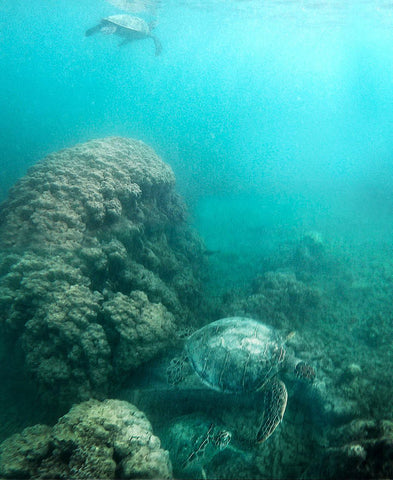
‘Ohana Nui gives 10% of its profits to protect our sea life, especially our endangered Hawaiian Green Sea Turtles.
For the first two years that I lived in Hawaii, not much of a person to lay around on the beach, I spent much of my recreational time hiking in the mountains. It was not until I met someone who was an avid open-water swimmer that I began to explore the ocean. I had previously been a tad scared of swimming in the open sea, having spent part of my youth living on the coast of northern California, where the water is murky grey and very cold. The waves there struck with such violence—not to mention that great white sharks live not far off the coast north of San Francisco. At best I would walk the beach, observing the magnificence of Mother Nature’s forces in action.
Hawaii is different. The water is warmer and generally clear, and is very inviting. But the game-changer here is that along large parts of the coast of Oahu, the water extends far out in quite shallow depths. The riptides and undertow that I feared on the California coast are generally not as significant here. Not to say that you can’t drown or be pulled out to sea in a strong current—but armed with an understanding of the tides, currents, and wind, many areas just off the coast are very swimmable and offer a view into the extraordinary world of coral, fish, turtles, and other amazing sea creatures.

Me and a friend.
Living so close to the beach, open water swimming has become a regular feature of my daily regimen—usually in the early morning. In developing my routine, I have also begun to see the routines of the sea creatures that dwell there; and I’ve noticed certain personality traits of the fish and turtles that I regularly encounter. For example, the sardines seem to like the shallows next to the beach in the early morning; and they don’t seem to be bothered by the swimmers, or the dogs that splash around them.

Morning rush hour of sardines.
Farther out on the reef are a few big heads of coral; the turtles enjoy eating the algae that collects there, but by afternoon they tuck themselves securely under the rocks for a nap, safe from the tides that could pull them out to deeper water. The turtles of Kaimana Beach are pretty rigid in their schedule. Three of them in particular live there, and I have begun to know them quite well. And as we humans do, I gave them names—Larry, Curly, and Mo. Larry and Curly were small, maybe 18” long at most andy are male or female [WHAT??] as the only way you can know is to do a comparative study of the size of their tails (turtles with smaller tails are female).

Mo, Larry, and Curly hanging out at Turtle Rock.

One day while swimming, I discovered Curly at the bottom of a large patch of sand in about ten feet of water. Something was wrong. He was just lying there, looking defeated. On closer inspection, I could see a fishing lure caught in his fin, and fishing line wrapped around his front fins and head. My heart sank. I raced back to the beach and alerted the lifeguard. He told me to call Hawaii Marine Animal Response team (HMAR), who would rescue the little fellow. I gave them a call and got their answering machine. What to do?! I raced home and grabbed what I thought I might need: some scissors, nail clippers, needle-nose pliers—anything I might need to cut the turtle out of the fishing line. There is a hefty fine for touching wild sea turtles, but there was no way I was going to let him die because of a few rules set up to keep tourists from trying to play with the turtles. Worst-case scenario, I would pay the fine and start a turtle rescue GoFundMe page to recoup the costs.
I ran back down to the beach. Luckily a woman from the HMAR was there. Together we organized a few people to swim out and try to save Curly. It took almost half an hour to detangle him. Once free he slowly swam off and back to the reef.

Getting the fishing lure off of Curly.
I felt an exhilaration that we had saved another being’s life; but also couldn’t stop thinking about how many more sea creatures would die or be injured by fishing lines—as well as from fishing nets, pollution that is filling our oceans, and the rise of the ocean’s water temperature as a result of global warming. Hawaiian Green Sea Turtles are an endangered species, along with the hawksbill, leatherback, and other turtles that frequent the seas around Hawaii, along with the Hawaiian monk seals, dolphins, and whales that all suffer from the threat of extinction.
As an individual, I had the opportunity to help one turtle in distress; but as a company, we can expand the awareness of the value of ocean life and be a conduit of action that might make a bigger difference. As a result of these experiences, 'Ohana Nui has committing a portion of our profits (starting at 10%) to protect our oceans and raise awareness of the critical state of our oceans. Let’s save our turtle friends (and all sea creatures)—one cookie at a time!


Comments
Very nice story Tom..great job with what you do for the turtles. Long way from PHS!
Great Work, Great Story, Tom and Team. With Appreciation and Aloha,
www.GeorgeHBalazs.com